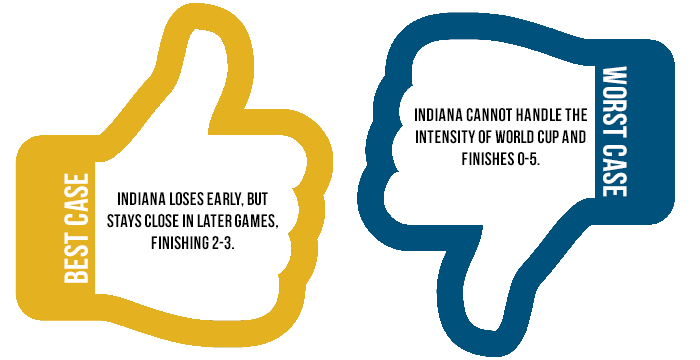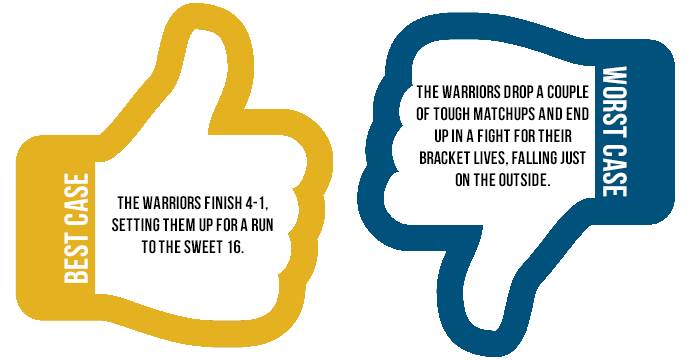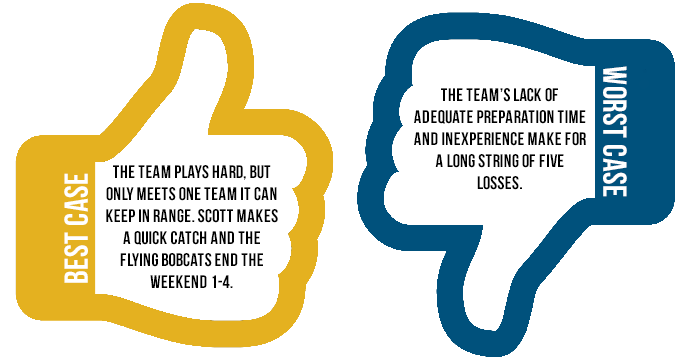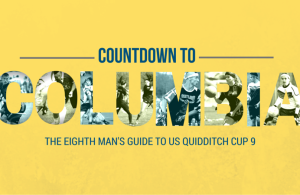- Rule, Britannia, no more?
- Unpopular Opinions: US Quadball Cup 2023
- Proven Contenders: University of Virginia
- Proven Contenders: Rutgers University
- Proven Contenders: University of Michigan
- Proven Contenders: Creighton University
- Different Perspectives: A Look Inside USA Ultimate
- Antwerp QC, Much of Belgian Core, Leaves Competitive Quidditch
Part XXIV
- Updated: April 6, 2015
Rock Hill Roll Call is your in-depth guide to the 80 teams that will compete for the title of World Cup 8 Champion. We’ve reached out to writers and analysts all over the country to bring you the lineups, strategies, focal points and aspirations of each and every attending team. Whether you are looking for a leg up on the competition or just want a detailed preview of the sport’s main event, this is the place for you.

 By Luke Changet
By Luke Changet
As harsh as it may seem, the x-factor for Indiana University is its luck in the draw. If the Midnight Snipes draw a team with a relatively solid defense, then they will be completely shut down.
Indiana has athletes, but because it is such a young program, this squad is still struggling to implement offensive systems. Currently, it looks like the Midnight Snipes’ game plan is to give the ball to one of their playmakers and hope they can weave through the whole defense and score. Yes, there are a few passes, but they are mostly perimeter passes and do not really open anything up for the offense.
If Indiana has any hope of making it to bracket play (a very long shot), they need to continuously get paired against teams with weak beaters. Indiana’s beaters are not fabulous, but they do have fairly solid positioning and are relatively good at regaining control. They struggle a bit with field awareness and are rarely go up on offense except to regain control; however, the Midnight Snipes’ beaters are the possibly the highlight of this program. If Indiana can find a way to utilize bludger control on offense with the 1.5 strategy, or even just by bringing beaters up to create space, then it could open things up on offense. If Indiana plays its usual game, then all an opposing team needs is one above-average defender and the Midnight Snipes’ entire offense will be shut down.
 By Luke Changet
By Luke Changet
Indiana’s starting line is fairly talented–it is when players start subbing that Indiana runs into some problems. When the team’s starters are in the game, Indiana is capable of hanging with all but the best of competition. Beyond a few more male chaser playmakers on the bench, Indiana does not have much in reserve, and it costs this squad later in games.
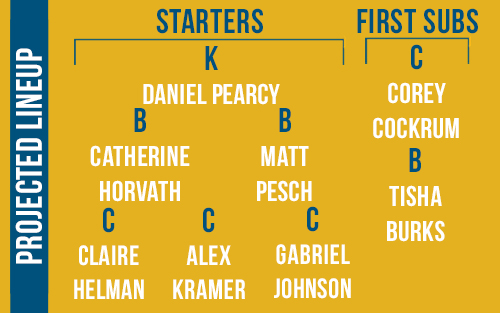 The Midnight Snipes have an aggressive and quick beater in Matt Pesch paired with Catherine Horvath, a respectable anchor beater. They have chasers Alex Kramer and Gabriel Johnson, both of whom can make most defenders miss, and their keeper, Daniel Pearcy, is an above-average ball handler as well.
The Midnight Snipes have an aggressive and quick beater in Matt Pesch paired with Catherine Horvath, a respectable anchor beater. They have chasers Alex Kramer and Gabriel Johnson, both of whom can make most defenders miss, and their keeper, Daniel Pearcy, is an above-average ball handler as well.
At regionals, the Midnight Snipes were able to hold their own against Ohio State University for five minutes but were eventually worn down and routed. If Indiana added even a couple of key players since its regional–or its key players can step up and play a bigger role–this team could do surprisingly well at World Cup. If the Midnight Snipes cannot do that, then their chances of any kind of success in Rock Hill are bleak.
 By Luke Changet
By Luke Changet
The Warriors’ hopes and dreams of triumph at World Cup 8 will live and die by Andrew Zagelbaum’s ability to catch snitches.
With The Warriors currently sitting with a season record of 4-3 in SWIM situations, their seeking performance is no guarantee. Zagelbaum has been inconsistent at best and came up short at the Northeast Regional Championship in The Warriors’ only in-range game–their semifinal performance against New York University. The highly-lauded seeker, originally from Macaulay Honors College, has a history of success in the lower tiers of play but is yet unproven at higher levels. The Warriors have yet to win a tournament this season, a blemish due in no small part to their seeker play.
 However, as is often the case, The Warriors’ seeker game is more about their beaters’ performance. This discrepancy became even more apparent after the loss of beater Chris Pavlovych. In their regional match against NYU, The Warriors switched to a two-male beater set as soon as the snitch became live. While this did buy Zagelbaum (and Billy Greco) some time on snitch, it also allowed NYU to take control of the quaffle game and, at times, to pull out of range. Typically though, The Warriors run a traditional male-female beater lineup for snitch situations. Now that Pavlovych is gone, the burden of this snitch game will fall to Jackson DellaRocca or John Glynn, partnered with Amanda Dallas. Whether they can step up is yet to be seen. The Warriors’ beater play has left them with something to prove—especially during snitch play—at World Cup.
However, as is often the case, The Warriors’ seeker game is more about their beaters’ performance. This discrepancy became even more apparent after the loss of beater Chris Pavlovych. In their regional match against NYU, The Warriors switched to a two-male beater set as soon as the snitch became live. While this did buy Zagelbaum (and Billy Greco) some time on snitch, it also allowed NYU to take control of the quaffle game and, at times, to pull out of range. Typically though, The Warriors run a traditional male-female beater lineup for snitch situations. Now that Pavlovych is gone, the burden of this snitch game will fall to Jackson DellaRocca or John Glynn, partnered with Amanda Dallas. Whether they can step up is yet to be seen. The Warriors’ beater play has left them with something to prove—especially during snitch play—at World Cup.
 By Luke Changet
By Luke Changet
Put simply, The Warriors boast a ridiculously daunting male chaser line.
If you want to see a team (outside of the Southwest) whose male chasers could carry it through World Cup, it is The Warriors. They have everything you could want in male-chaser rotations. If they want to go big and physical, look for Steve Hysick and Taylor Crawford to get a lot of minutes. If they need to use speed to get around opposing defenders, Michael Parada and Sean Beloff can do just that. To back up all this talent, they have Alex Linde, an incredible playmaker from the keeper position. They do have a reliable female in Missy Hanley, but, overall, their females are far less versatile and work in more of a complementary role, camping around the hoops and looking for easy goals.
If The Warriors can come out and dominate the chaser game early in the day and are lucky enough to avoid a great beating team until later, they could do incredibly well at World Cup. Their chasers are good enough to carry them over any team without outstanding beaters, and if they choose to put two male beaters on the snitch game, there will be plenty of opportunities for Zagelbaum to solidify his record.
 By Anonymous
By Anonymous
Despite being crowned the best team in the South Region this year, it is evident Florida’s Finest qualified thanks to individual performances rather than team achievements. A successful run at World Cup 8 will require either a drastic change toward a more team-oriented mentality, or a continuation of the superstar performances that characterized this team at its regional championship.
While a complete team makeover is unlikely, the Flamingos do have Team USA beater Sean Pagoada, who can take over a game singlehandedly at any moment. If Florida’s Finest wants to live up to its own expectations, it is going to need Pagoada to play a dominant and controlling style at multiple positions, continuing the versatile utility he has shown throughout the season.
Pagoada will typically start off matches as part of the chaser line, where he can control the game through a steady offense based on his speed and finishing abilities. However, if the team finds itself outclassed in the beater game, Pagoada will switch headbands and start directing traffic as a beater—arguably his best position. When the team is in snitch range he will also enter the seeker rotation, and has come up with clutch grabs when the Flamingos have needed him.
With only one loss on the year, the current system has worked for Pagoada and his team in the South. Its true test at World Cup will be to see how well the team’s over dependence on a single playmaker works against a higher level of competition than its usual opponents, especially during a two-day event.
 By Anonymous
By Anonymous
The South Regional champions, Florida’s Finest, will be working to beat opponents with pure athleticism and experience, both of which the team has in plenty. The Flamingos have cruised past most opponents this year thanks to those skills and the leadership of captain Pagoada, but they run the risk of becoming vulnerable to other teams that can match their athleticism or counter it with superior game planning at World Cup.
On offense, the Flamingos work the ball with simple passes around the perimeter, looking to give one of their physical male chasers a driving lane with minimal interference from opposing beaters. This makes for a coordinated hero-balling scheme with Pagoada, Devon McCoy and Sean Snipes at chaser, while beater Ryan Haggard brings the hurt to the opposing team’s beaters with an aggressive 1.5 bludger play. Florida’s Finest also makes a point to keep games tight, quickly recovering after goals are given up. While the other team transitions back to defense, the Flamingos will look to take advantage of any laxity in the transition with a powerful run through unprepared defenses.
 On defense, the team will rely on its athleticism to keep up with offensive chasers, implementing a tight man-marking strategy. The chasers are good at marking in open space, but they will sometimes struggle against teams that run coordinated offenses and force them to change marks. The defensive beating game remains lackluster. The male beaters—Curtis Taylor and Bobby Padan—are very good, especially at protecting against the 1.5 bludger offense, but the team’s female beaters are typically unable to capitalize on the extra time given to them by their male partners due to a lack of speed and arm strength.
On defense, the team will rely on its athleticism to keep up with offensive chasers, implementing a tight man-marking strategy. The chasers are good at marking in open space, but they will sometimes struggle against teams that run coordinated offenses and force them to change marks. The defensive beating game remains lackluster. The male beaters—Curtis Taylor and Bobby Padan—are very good, especially at protecting against the 1.5 bludger offense, but the team’s female beaters are typically unable to capitalize on the extra time given to them by their male partners due to a lack of speed and arm strength.
A team that can match the physicality of Florida’s Finest and seal off its driving lanes, forcing itinto a precise passing game while running a clean and calculated game on offense, will be a nightmare for the king of the South. However, even these teams will likely need to put the Flamingos out of range before feeling truly comfortable, as Florida’s Finest possess one of the strongest seeker rotations in the league with seamless transitions between Pagoada, Taylor and Emilio De Narvaez facing off against the snitch. 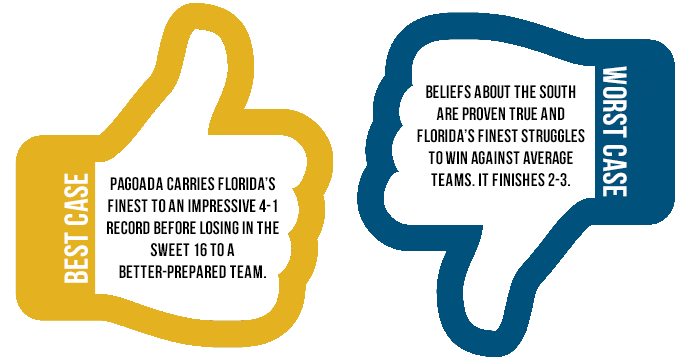
 By Eric Wasser
By Eric Wasser
Quidditch is a tough sport for recruiting players, and retention is just as hard—especially when a team is not preparing for World Cup competition. Ohio University got a huge boost to the program’s talent with the addition of first-year player and senior keeper, Jeff July. July is a large keeper, standing at about 6-foot-3, with excellent reach to cover the hoops. He complements his shot-blocking reach with a propensity for physicality, making drives to the hoops as challenging as shooting around him. July’s willingness to stick with the program after the Midwest Regional Championship in November in order to improve his own play as well as that of the team have turned into a huge boon for this Ohio squad, as it recently claimed a deferred bid to World Cup 8.
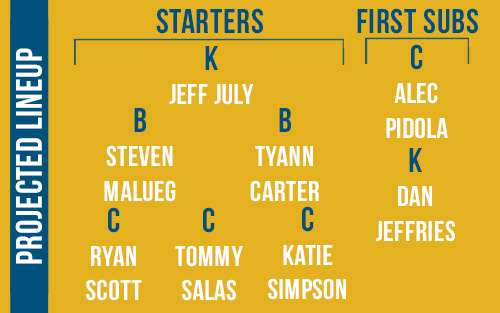 Serving as the centerpiece of Ohio’s hoop zone, July adds a physicality that the young Flying Bobcats team lacked before rounding out the basis for a solid defense. If captains Ryan Scott and Steven Malueg can build off of the team’s experiences against quality squads from recent tournaments, there is a distinct possibility that Ohio will pull out some wins.
Serving as the centerpiece of Ohio’s hoop zone, July adds a physicality that the young Flying Bobcats team lacked before rounding out the basis for a solid defense. If captains Ryan Scott and Steven Malueg can build off of the team’s experiences against quality squads from recent tournaments, there is a distinct possibility that Ohio will pull out some wins.
However, for this to happen, the Flying Bobcats will also need to generate significantly more of an offensive presence than usual. If they are able to utilize July’s size in combination with their more experienced players getting him open to drive, then this team could definitely surprise people.
 By Eric Wasser
By Eric Wasser
More teams have been adopting zone defenses this season than in previous years, but most of these zones are not based around teams’ skills or strategic devices and are instead a crutch for weaker teams that cannot find a defensive identity. At its best, a forced zone may stop a couple of long shots, but, ultimately, it will not win any games if it is not perfected and appropriate for the team structure.
Ohio, however, is perfectly tailored to the three-man zone and has disciplined it well. With July covering the middle hoop, Scott on the right and a complement of smaller chasers on the left, the team has the right amount of physicality to prevent easy drives and the size to make shooting tricky. If the Flying Bobcats can maintain control at the edge of the keeper zone with their beaters, then they will have a well-rounded defense.


